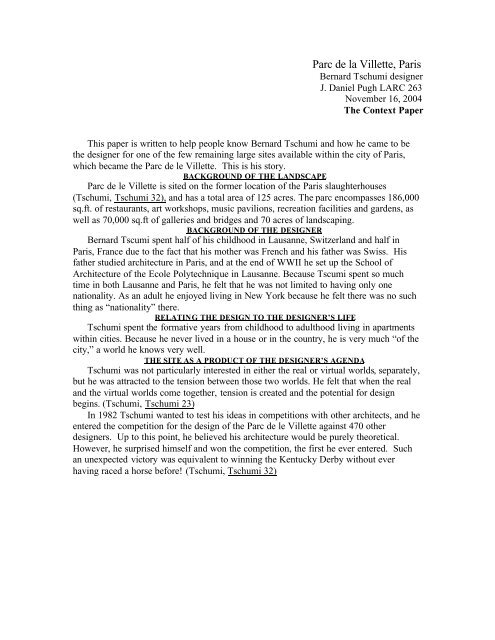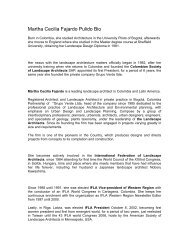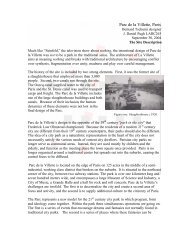Parc de la Villette Context - Landscape Architecture
Parc de la Villette Context - Landscape Architecture
Parc de la Villette Context - Landscape Architecture
You also want an ePaper? Increase the reach of your titles
YUMPU automatically turns print PDFs into web optimized ePapers that Google loves.
<strong>Parc</strong> <strong>de</strong> <strong>la</strong> <strong>Villette</strong>, Paris<br />
Bernard Tschumi <strong>de</strong>signer<br />
J. Daniel Pugh LARC 263<br />
November 16, 2004<br />
The <strong>Context</strong> Paper<br />
This paper is written to help people know Bernard Tschumi and how he came to be<br />
the <strong>de</strong>signer for one of the few remaining <strong>la</strong>rge sites avai<strong>la</strong>ble within the city of Paris,<br />
which became the <strong>Parc</strong> <strong>de</strong> le <strong>Villette</strong>. This is his story.<br />
BACKGROUND OF THE LANDSCAPE<br />
<strong>Parc</strong> <strong>de</strong> le <strong>Villette</strong> is sited on the former location of the Paris s<strong>la</strong>ughterhouses<br />
(Tschumi, Tschumi 32), and has a total area of 125 acres. The parc encompasses 186,000<br />
sq.ft. of restaurants, art workshops, music pavilions, recreation facilities and gar<strong>de</strong>ns, as<br />
well as 70,000 sq.ft of galleries and bridges and 70 acres of <strong>la</strong>ndscaping.<br />
BACKGROUND OF THE DESIGNER<br />
Bernard Tscumi spent half of his childhood in Lausanne, Switzer<strong>la</strong>nd and half in<br />
Paris, France due to the fact that his mother was French and his father was Swiss. His<br />
father studied architecture in Paris, and at the end of WWII he set up the School of<br />
<strong>Architecture</strong> of the Ecole Polytechnique in Lausanne. Because Tscumi spent so much<br />
time in both Lausanne and Paris, he felt that he was not limited to having only one<br />
nationality. As an adult he enjoyed living in New York because he felt there was no such<br />
thing as “nationality” there.<br />
RELATING THE DESIGN TO THE DESIGNER’S LIFE<br />
Tschumi spent the formative years from childhood to adulthood living in apartments<br />
within cities. Because he never lived in a house or in the country, he is very much “of the<br />
city,” a world he knows very well.<br />
THE SITE AS A PRODUCT OF THE DESIGNER’S AGENDA<br />
Tschumi was not particu<strong>la</strong>rly interested in either the real or virtual worlds, separately,<br />
but he was attracted to the tension between those two worlds. He felt that when the real<br />
and the virtual worlds come together, tension is created and the potential for <strong>de</strong>sign<br />
begins. (Tschumi, Tschumi 23)<br />
In 1982 Tschumi wanted to test his i<strong>de</strong>as in competitions with other architects, and he<br />
entered the competition for the <strong>de</strong>sign of the <strong>Parc</strong> <strong>de</strong> le <strong>Villette</strong> against 470 other<br />
<strong>de</strong>signers. Up to this point, he believed his architecture would be purely theoretical.<br />
However, he surprised himself and won the competition, the first he ever entered. Such<br />
an unexpected victory was equivalent to winning the Kentucky Derby without ever<br />
having raced a horse before! (Tschumi, Tschumi 32)
In Tschumi’s mind the <strong>Parc</strong> <strong>de</strong> le<br />
<strong>Villette</strong> was not a park but a new type of<br />
city. Despite the fact that he started with an<br />
old industrial site, he <strong>de</strong>ci<strong>de</strong>d that his <strong>de</strong>sign<br />
would not be contextual nor would it<br />
recreate or refer to things from the old site.<br />
Instead, he was starting from a pure<br />
concept, and for inspiration he looked at<br />
general concepts of <strong>la</strong>rge organizations and<br />
how they fit into the city of Paris. After<br />
testing the superimpositions of abstract<br />
concepts about organization, he <strong>de</strong>ci<strong>de</strong>d the<br />
point-grid system worked best and that the<br />
concept of the discontinuous city would be<br />
the starting point for his <strong>de</strong>sign of the parc.<br />
(Tschumi, Tschumi 32,44)<br />
When Tschumi first ma<strong>de</strong> his <strong>de</strong>sign presentation to Presi<strong>de</strong>nt Mitterand, he brought<br />
four park <strong>de</strong>signs with him: First was the 18 th century park at Versailles; second was the<br />
19 th century park of Les Buttes-Chaumont in Paris; third was a 20 th century park,<br />
Brazilia, un<strong>de</strong>r construction; and fourth he presented La <strong>Villette</strong> as the new 21 st century<br />
park. (Tschumi, Tschumi 45) Tschumi’s <strong>de</strong>sign of the <strong>Parc</strong> <strong>de</strong> <strong>la</strong> <strong>Villette</strong> is<br />
anticontextual, has no re<strong>la</strong>tion to its surroundings, and subverts bor<strong>de</strong>rs on which<br />
“context” <strong>de</strong>pends. (Lissarrague vi)<br />
While Tschumi had resisted the<br />
i<strong>de</strong>a of ‘contextualism’ for <strong>Parc</strong> <strong>de</strong> le<br />
<strong>Villette</strong>, it does work well within its<br />
context. The axis of the 19 th Century<br />
cast-iron market hall is not quite<br />
perpendicu<strong>la</strong>r to the canal, and this<br />
allows the north-south gallery to travel<br />
slowly from the west to the east and<br />
move across the grid of the folies. The<br />
folies run precisely parallel to the canal<br />
and the line of movement challenges<br />
the architecture. This is not an<br />
aesthetic choice but one following the<br />
logic of Tschumi’s <strong>de</strong>sign. “I’m not<br />
interested in composition, but in<br />
montage,” he exp<strong>la</strong>ined. (Tschumi,<br />
Tschumi 50) “I think the park works<br />
very well functionally and visually<br />
with the other projects built around the<br />
site, such as Cité <strong>de</strong> <strong>la</strong> Musique by<br />
Christian <strong>de</strong> Portzamparc, the Zenith,<br />
and the Museum of Science and<br />
Technology. The site is so charged<br />
Where the <strong>Parc</strong> meets the built world<br />
2
with different approaches to <strong>de</strong>sign. I think our folies provi<strong>de</strong> a way to punctuate and<br />
articu<strong>la</strong>te the whole.” (Tschumi, Tschumi 51)<br />
Tschumi seemed to enjoy the various reactions his <strong>de</strong>sign elicits: “Here nobody<br />
knows what that image or theme is. People do react to the park, though. They like it or<br />
hate it, although most don’t un<strong>de</strong>rstand it. And that’s fine with me, because I don’t want<br />
it to be so easy to un<strong>de</strong>rstand. I want it to be used as a mirror of their questions.”<br />
(Tschumi, Tschumi 51)<br />
CONTEXT OF OTHER WORKS CREATED BY THE DESIGNER<br />
As stated earlier, <strong>Parc</strong> <strong>de</strong> le <strong>Villette</strong> was Tschumi’s first competition. Up to this point<br />
he had been teaching architectural theory. Now he wanted to test his theories against<br />
other <strong>de</strong>signers. The <strong>Parc</strong> <strong>de</strong> le <strong>Villette</strong> competition was particu<strong>la</strong>rly difficult to grasp for<br />
many of the competitors, but Tschumi did not see it that way because he found it more<br />
challenging to work on difficult projects than on easy ones. (Tschumi, Tschumi 19)<br />
Tschumi’s first projects, “Rituals,” explore the re<strong>la</strong>tions between space, movement,<br />
and action. His second project types draw on his first works with movement. He uses a<br />
randomly curved vector crossing through a grid; a vector as a <strong>la</strong>ndscape; vector as<br />
infrastructure and vectors that go against “normative contexts.” His third works, voids<br />
and solids, explore the architectural <strong>de</strong>vice of carving into solids to create “void” spaces.<br />
His fourth project types encourage activation of the void created. He does this by<br />
increasing the intensity of the space with public activities. Tschumi’s fifth project type is<br />
the envelope. It is the common <strong>de</strong>nominator of all architecture, the enclosure (Tschumi,<br />
Event 12)<br />
EVENTS OF THE PERIOD THAT MAY HAVE INFLUENCED THE DESIGN<br />
It took ten years for Tschumi’s i<strong>de</strong>as to become the architectural p<strong>la</strong>ns he submitted<br />
to the <strong>Parc</strong> <strong>de</strong> <strong>Villette</strong> Competition in 1983. The events during his time in London<br />
between 1970 and 1976 were formative to the <strong>de</strong>sign he submitted in 1983, more<br />
formative than the events of 1983. In 1970 he began teaching at the Architectural<br />
Association in London and had the opportunity to meet many young architects that ten<br />
years <strong>la</strong>ter would collectively be <strong>de</strong>veloping a new architectural<br />
sensibility. It was a very dynamic time for these <strong>de</strong>signers.<br />
(Tschumi, Tschumi 16)<br />
In 1976 Tschumi gave his stu<strong>de</strong>nts at the Architectural<br />
Association a project: They were to take James Joyce’s Finnegans<br />
Wake and <strong>de</strong>sign a <strong>la</strong>ndscape p<strong>la</strong>n from the text. Each stu<strong>de</strong>nt<br />
was assigned a point on a grid of Covent Gar<strong>de</strong>n in London,<br />
Tschumi’s way of organizing the stu<strong>de</strong>nts to get a lot of work<br />
done. This project was named Joyce’s Gar<strong>de</strong>n and would be one<br />
of the concepts used for <strong>Parc</strong> <strong>de</strong> le <strong>Villette</strong> seven years <strong>la</strong>ter.<br />
(Tschumi, Tschumi 44)<br />
Joyce’s Gar<strong>de</strong>n with point grid<br />
point grid<br />
In 1976 Tschumi was doing some research called the Screenp<strong>la</strong>ys or the Manhattan<br />
Transcripts in which he was experimenting with movement, events and the systems of<br />
points, lines and surfaces. He was testing i<strong>de</strong>as on movements and the dynamic of events<br />
and activity, and this became his <strong>de</strong>ciding strategy to enter the competition for <strong>Parc</strong> <strong>de</strong> le<br />
<strong>Villette</strong> and use multiple <strong>de</strong>vices to organize complexity.<br />
3
SOCIAL AND ECONOMIC STRUCTURE OF THE PERIOD<br />
Large public projects in France tend to have centralized <strong>de</strong>cision making;<br />
consequently, a politician with real power does not have to get approval from a<br />
committee or governing body. That is why Presi<strong>de</strong>nt Mitterand was able to secure 300<br />
million dol<strong>la</strong>rs for the construction of <strong>Parc</strong> <strong>de</strong> le <strong>Villette</strong>. While there were <strong>de</strong>bates,<br />
arguments and newspaper editorials about the project, none of this was as difficult as the<br />
process of getting a comparably sized project completed in the United States. (Tschumi,<br />
Tschumi 24)<br />
STATE OF THE FINE AND APPLIED ARTS<br />
“ The competition for the <strong>Parc</strong> <strong>de</strong> <strong>la</strong> <strong>Villette</strong> was the first of the international<br />
architectural competitions in Paris in the 1980’s, all of which were part of a major<br />
cultural and political effort to restructure entire areas of the French capital,” according to<br />
Bernard Tschumi. (Kipnis 125)<br />
INFLUENCE OF SCIENTIFIC DISCOVERY<br />
During a 1997 interview Bernard Tschumi indicated, “Architects will begin to do a<br />
lot of work in terms of building technology. This is something I refer to as glue and<br />
microchips. Of course, I’m referring to two technologies here: building technology and<br />
computer technology. These two things together will have far more impact than anything<br />
about form. I think that it is here that a fascination exists, and I think we are in a very<br />
exciting period. I think that in these ways architecture is still a young discipline, with a<br />
long way to go.” (Tschumi, Tschumi 23)<br />
SENSIBILITIES & FINANCES OF THE CLIENT<br />
Bernard Tscumi’s client was the French Government, and in 1982 it was not known if<br />
the government had budgeted money for the project. The government was also about to<br />
change. The project started un<strong>de</strong>r Mitterand, but in 1986 a new government from the<br />
right came to power and nearly en<strong>de</strong>d the project. This political vo<strong>la</strong>tility would <strong>la</strong>st<br />
through most of the next twelve years of the parc’s construction. At times, the project<br />
would stop for six months before more funding could be found. (Tschumi, Tschumi 45)<br />
POSSIBLE RELATIONSHIP TO HISTORIC PRECEDENTS<br />
Concepts from other disciplines, film or philosophy were introduced at this<br />
competition, and Tschumi intentionally did not want to represent an architectural<br />
heritage. His <strong>de</strong>cision upset many people, including the architectural establishment. The<br />
French press was also quite critical, but his <strong>de</strong>sign did get supportive coverage from the<br />
international media. (Tschumi, Tschumi 48) Peter Eisenman said, “It is the ‘difference<br />
between’ that was being sought. Atopia is literally ‘no p<strong>la</strong>ce’ or ‘without p<strong>la</strong>ce.’ In or<strong>de</strong>r<br />
to un<strong>de</strong>rstand the nature of this disp<strong>la</strong>cement, the nature of traditional p<strong>la</strong>ce must be<br />
<strong>de</strong>fined. The concept of urban p<strong>la</strong>ce has been associated with a boun<strong>de</strong>d or framed<br />
unitary condition of presence. Unlike the Japanese conception of ma as ‘space between’<br />
and mu as ‘no p<strong>la</strong>ce,’ both of which imply a very real condition of a presence in a<br />
condition of absence, Western conceptions of p<strong>la</strong>ce are always presence boun<strong>de</strong>d as well<br />
as being groun<strong>de</strong>d to a specific location.” (Kipnis 135)<br />
Tschumi summarized the intent and fulfillment of his <strong>de</strong>sign by saying, “Our project<br />
is motivated by the most constructive principle within the legitimate ‘history’ of<br />
architecture, by which new programmatic <strong>de</strong>velopments and inspirations result in new<br />
typologies. Our ambition is to create a new mo<strong>de</strong>l in which program, form and i<strong>de</strong>ology<br />
all p<strong>la</strong>y integral roles.” (Barzi<strong>la</strong>y 38)<br />
4
During the 19 th century Fre<strong>de</strong>rick Law Olmsted brought a “representation” of the<br />
natural world to cities. In the 20 th century parks are no longer “separate” from the city—<br />
replications of nature, dropped into an urban world. The park for the 21 st century is<br />
integrated within the functions of the city, and it needs to complement the vision of the<br />
city so that the city will exist within the park and embrace urban reality. (Lissarrague 1)<br />
Conclusion<br />
In French, “La <strong>Villette</strong> means little city.” Through the force of his revolutionary<br />
<strong>de</strong>sign, Tschumi was able to anticipate the future of Paris in his gift to the city—the <strong>Parc</strong><br />
<strong>de</strong> le <strong>Villette</strong>.<br />
BIBLIOGRAPHY<br />
Tschumi, Bernard. Bernard Tschumi / edited and photographed by Yukio Futugawa.<br />
Tokyo: A.D.A. Edita, 1997.<br />
Kipnis, Jeffrey and Thomas Leeser, eds. Chora L works: Jacques Derrida and Peter<br />
Eisenman. New York: Monacelli Press, 1997.<br />
Barzi<strong>la</strong>y, Marianne, Catherine Hayward, and Lucette Lombard-Valentino. L’Invention<br />
dup arc. Paris: Graphite Editions, 1984.<br />
Tschumi, Bernard. Event-cities 2 / Bernard Tschumi. Cambridge, MA: MIT Press, 2000.<br />
Lissarrague, Jacques. La Cite’ <strong>de</strong>s sciences et <strong>de</strong> l’industrie, Paris-La <strong>Villette</strong>. Paris:<br />
Electra Moniteur, 1988.<br />
5





